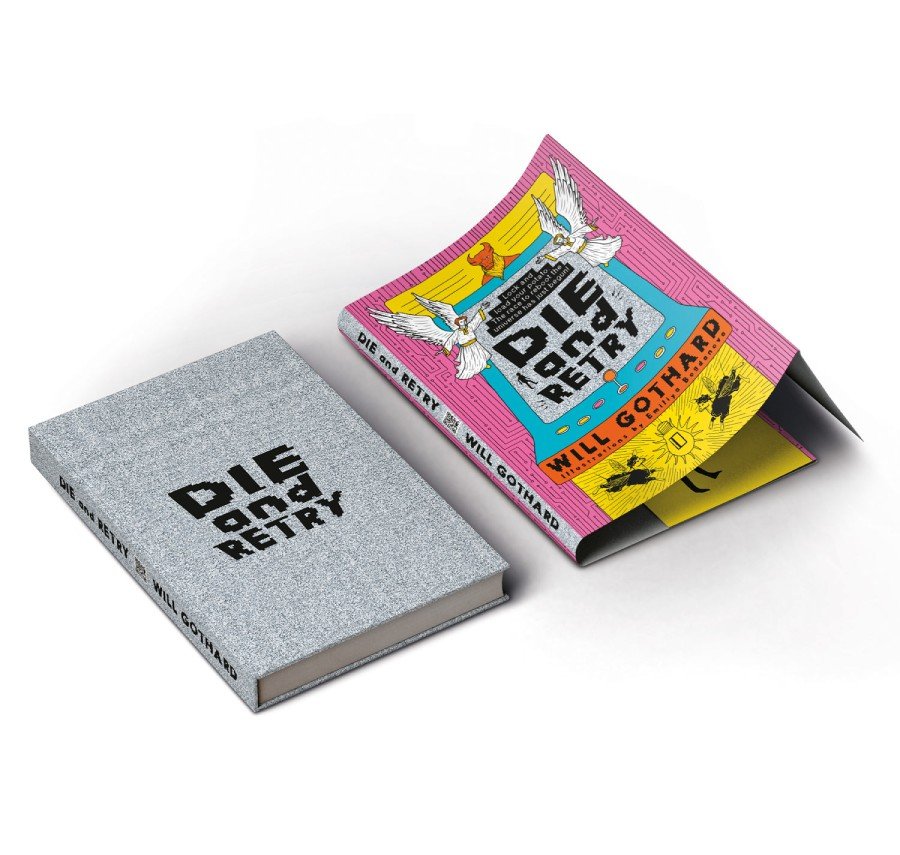TIPS AND TRICKS FOR A CREATIVE BOOK COVER DESIGN
Book cover designs need to stand out more than ever, competing for the space in physical bookstores, online bookstores, and social media. So designers have really upped their game, creating covers that people even appreciate as art in itself.
You want everything on the cover – the imagery, the fonts, the colors – to reflect your book's story. A creative cover design should hint at the genre and tell the audience something about your book's personality. But most importantly, a creative design should be bold and intriguing so it attracts attention on the shelf.
Quick Reference
What goes into a creative book cover design?
4 examples of creative book cover design
What goes into a creative book cover design?
The idea behind a creative design is that you shouldn't limit yourself to any strict rules. Be inventive; let your imagination and creativity do the work. But keep in mind that the design should convey the book's essence and suit your target readers.
That said, it's helpful to remember a few pointers so that your cover will be both functional and creative.
The cover design should match the contents of your book
A cover that's true to the story is just as important as creating something memorable. Don't lure readers in with a particular design if the actual book is different. That means you haven't found the right readers, and the ones that do read it may be disappointed. Remember that your book cover should set the right tone of voice and genre, trigger the right emotions, and draw curiosity from your readers.
When we say the cover needs to match the contents, it doesn't have to be literal. In fact, the most exciting covers suggest rather than explicitly show what the book is about. In the same way as when you write fiction – "show, don't tell" is an axiom to keep in mind for your book cover.
Don't go overboard
We believe in letting your imagination run wild – there's no right or wrong in the creative process. But you don't want to pack 200 cool ideas into one book cover. That's why editing and perhaps ‘killing your darlings’ is an important step in the creative process.
Try to keep the decorative elements down to just a few, or you risk weakening the main concept. With too much on there, you'll undermine your core message and end up with a messy and unclear cover. In turn, it can confuse potential readers, and they may not take a closer look at your book.
Form follows function
An essential principle in the design industry is that form follows function. Simply put, the primary purpose of the design is to communicate a message, and the message should be clear enough for the audience to comprehend it.
One flaw you'll see with some creative book cover designs is that they can be hard to read, or the audience can't grasp what's going on. Although experimenting with different fonts and color schemes can work in your favor, remember that you only have a short window to attract a reader's attention.
4 examples of Coverkitchen’s creative book cover designs
Combining STOCK PHOTOS to execute a STRONG CONCEPT
LOST IN BEIRUT
This is the true story of a rising Hollywood actor who travels to Beirut with his friend to promote Lebanon's largest concert. It's 2006, and he finds himself going from bathing in Beirut's glamorous nightlife to suddenly plunging into war – followed by a frantic escape across Syria and Jordan.
The cover concept revolves around the strongest theme in the memoir: the two clashing realities – a luxury lifestyle and being in the midst of a war.
One of our first ideas was an immaculate Ferrari parked amidst the rubble of bombed buildings. However, this felt prosaic and on the nose. The published cover presents a poetic yet ominous image: as this man bomb dives into the pool of a 5-star resort, an Israeli missile is about to strike. We merged four different stock photos to create an artistic photograph (pool, man, missile, and sky) to create the final image.
The title and author set in one line suggest a thin border separating the two realities about to shatter.
Lost in Beirut is an excellent example of how creativity can add value to the cover design. Instead of repeating the design from the jacket, an explosion on the case laminate will surprise readers as a visual aftermath to the cover.
VISUAL INTERPLAY between covers in a BOOK SERIES using IN-HOUSE ILLUSTRATION
WHERE THEY BURN BOOKS, and THEY ALSO BURN PEOPLE are two standalone books with alternating chapters. One pulled from the pages of history, interwoven with the other imagining its implications for the present over 400 years apart in America.
A third book, titled WHERE THEY BURN BOOKS, THEY ALSO BURN PEOPLE, combines both books into one. Instead of designing three different covers for each title, we created a holistic design for the third book, perfectly interweaving across the three covers in the same manner as the chapters.
Each cover element derives from our in-depth research on conflicting symbols between the Maya and Christian cultures present in the novels. For instance, a skull represents death to Christians, while it symbolized regeneration to Mayas. Fire is the common thread that adds tragedy and places the book within the magical realism genre.
CREATIVITY that builds VALUE-ADDED design.
The challenge to design book covers for self-publishing platforms, such as IngramSpark and KDP, is to overcome the limitation of print-on-demand production finishing and the fewer materials available.
While traditional offset presses can offer many different kinds of papers and printing finishing like foil stamping, embossing, UV varnish, or die-cutting, print-on-demand companies can only provide paperback or hardcover and matte or glossy as finishing.
We use creativity to build value-added designs to offset these production limitations. DIE AND RETRY is an excellent example of how art direction can pull elements from the narrative in the book to create a meaningful and interactive design. Here, the static noise on the arcade screen on the jacket takes the reader into the virtual world on the case laminate.
See more about DIE AND RETRY and other projects in the young adult book cover genre.
3D ART to create REALISTIC IMAGINED WORLDS
TALE OF THE SECONDHAND STRANGER
3D rendering works great for fantasy and science fiction to create photo realistic and cinematic images that make imagined worlds believable.
Using our in-house hardware and software resources, we generated different renders of the same 3D figure from the same point of view with progressively fewer clothes followed by layers of muscle, skin, and skeleton mapping.
The final image is the result of the four generated images merged into one.
See more in-house image-making skill sets.
What we need to start your book design
So what goes into the process of creating a book cover design? At Coverkitchen, we typically follow specific steps to get to know you, the author, and understand your vision. But before the book design begins, there are a few questions we need to ask.
Who's the author and their brand?
Are you well-established or up and coming – perhaps publishing a debut? Do you have a big following on social media? This part of the process is about getting to know each other – figuring out your style, brand, and personality so that your cover design resonates with who you are.
What is the genre, and does it have an established style?
Commercial fiction falls into several genres such as fantasy, thriller, romance, or sci-fi. Genres like these usually have distinct cover designs that are well-established. The trick is to create a cover that conveys the genre while having unique elements and a personal touch.
Where are you selling the book?
Where you're planning on selling your book can significantly impact the design. The main question is whether it will print or be sold only as an e-book. If it's going to be a thumbnail on Amazon, the designers need to consider this.
Who is your publisher and what is your production budget ?
Many printers offer premium options like thicker paper weights, varnishing, and embossing. Self-publishing platforms are the most popular choice among self-publishing authors since it’s suitable to produce small quantities, short production time and cost-efficiently as needed. But it comes with the limitations of materials and finishing.
It is important to discuss what features you want and the budget you have, so we can use our creativity to maximize production availability, or to create the design that overcomes the limitations.
Our design process in 7 steps
Now that we've gathered some information about you, the creative work can begin. Here's an outline of what the process usually looks like.
Knowing the key aspects of your book content.
Filling in our book design brief form is the first step that helps us understand the book at a deeper level and gives us the information we need to create a successful book cover. For example: What's the most crucial element of the story? What’s your book's first and secondary theme? What are the main characters and setting?Doing market research.
Based on your genre and target audiences, we'll research the market to understand what works from a sales point of view.Building a strong concept.
We build a strong concept around the information you briefed us in the book design brief form. A strong concept will allow your book to have a wide range of design possibilities and higher chances to succeed in communicating what it’s about and drawing curiosity from your target readers at a glance.Choosing design direction.
After the core concept is settled, we’re ready to explore the designs, guided with art direction that will make sure the designs fit with the ideas and resonate with your target audience.Deciding on graphic styles and fonts.
Narrowing down and choosing the right graphic style can be challenging. We take our time to craft the perfect graphics with our in-house image making skill sets and to find the most suitable fonts, or create custom lettering, to communicate the core message of your book.Collecting feedback.
We can evaluate whether the design is missing something by getting more eyes on your cover before it hits the shelves.Sending off for printing.
The final step is to organize everything into the final file for your book project. Our team will help you with any questions or problems you face during the production process.
Do you need help with your book cover design? We create book cover concepts for authors worldwide. Get in touch to discuss your project.








